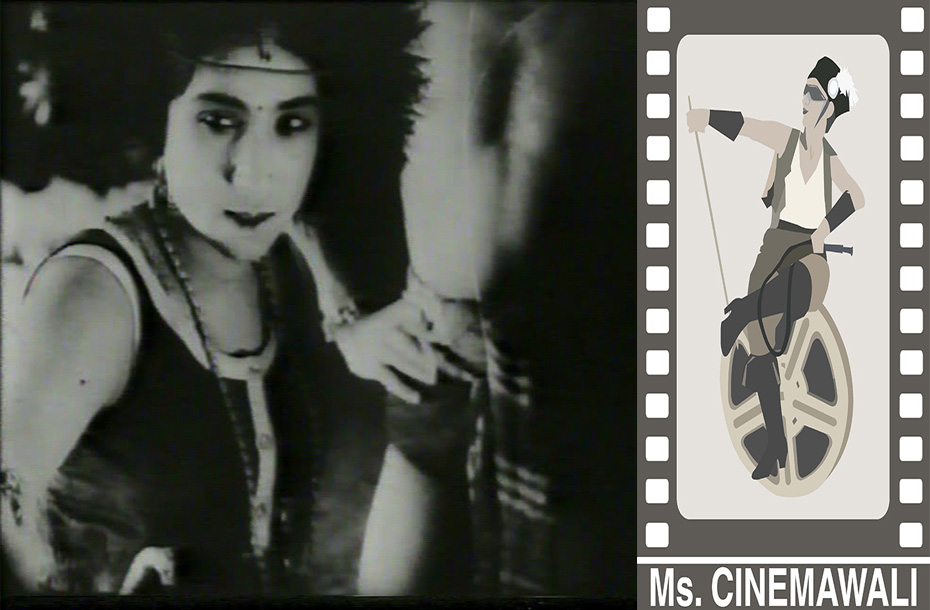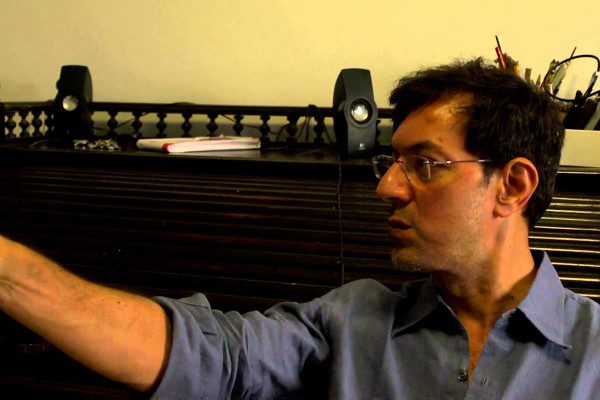About the column: This series presents short articles and photo-essays on the industrial aspects of cinema produced from Bombay aka Bollywood. Stories of the making of Bollywood, stars, publicity mechanisms, fan cultures, gossips, costumes, music usage, playback systems, singers, composers, as well as writings by the players and so on. The film industry, however, will be seen through the pointed glasses of women, intricately linking all the narratives of one ‘Miss Cinemawali’ or the other.
What is the image that comes to your mind when you hear the name”Lalita Pawar”? Miss Cinemawali brings to you another image, we bet. By Madhuja Mukherjee.
Those of us who know the black and white Hindi films from the 1950s would perhaps remember the curious face of an‘evil’ woman, whose one eye was smaller than the other. While in films like Sree 420(1955) or in Anand(1970)Lalita Pawar performed the ‘mother’ figure, in other films of the period she quickly transformed into a villainous mother-in-law or a domineering matron. Some of Lalita Pawar’s well-known films are Mr. and Mrs. 1955 (1955), Nau Do Gyarah (1957), Anari (1959), Sujuta (1959) etc. Born in 1916, as the story goes, Lalita Pawar was slapped so hard by a fellow actor that she lost one of her eyes.[i] Narratives of female actors negotiating challenging conditions during shooting is not a novel thing; nevertheless, it is imperative to note that, Lalita Pawar was truly one of the early ‘stunt’ artists whose boisterous actions crafted a new direction for early cinemas.[ii]
Ashish Rajadhyaksha (1994) writes how early Indian films – also categorized as ‘silent’ cinema – predate popular melodramas of the 1940s and 1950. For instance, Diler Jigar (1931) includes discreet narrative transitions like dissolves, and thereby frames a ‘flash forward’, which was truly unique at that time. Agarwal Film Company produced Diler Jigar, and the film presented Lalita Pawar along with her husband G.P. Pawar (who was well known for reviving action films in the 1920s).[iii]
In this context, however, we will not analyze the import or popularity of ‘action’ genre/ stunt films or the processes through which these films were categorized as B-movies, despite the fact that they allow us to reflect upon early cinemas.[iv] What I wish to highlight is the marvelous performer Lalita Pawar, and the ease with which she executed sword fights and other action sequences. DilerJigar, for instance, combines the fantastic costumes and feats of Douglas Fairbanks’ Mask of Zorro (1920) with disparate balletic styles of the Nautanki etc. Rajadhyaksha shows how (1994: 34):
Hameer [the male protagonist] leaps about fighting the massed [sic. Masked] soldiers of the [evil] King, so he moves – at times with dizzying rapidity –from forest to garden to the palatial courtyards, to corridors and the King’s sanctum and eventually into the space of the oppressed proletarian….
Then again, one may argue that, this wondrous drive was equally ‘hers’ and Lalita Pawar’s. In fact, towards the end of the film, Pawar wears the mask of Zorro and rescues the hero. Indeed, we along with this robust man wonder, ‘Who are you?’ Thus, to re-frame Rajadhyaksha’s words from another context (1994: 35), “In this film, Saranga [Lalita Pawar] is indeed liberated.” And, “the liberation effectively inaugurates the hugely popular convention of demure woman turning masked Westernized challengers….” This is not to state that DilerJigar is an early feminist film of sorts. The attempt is to explore the ways in which Lalita Pawar’s gestures and expressions may have created a rupture within the mainstream-popular. Or to reuse Valentina Vitali’s (2008: 69) words, “[a] space opened up between role and presence in which a particular actress may inscribe her sense of agency …”
Writing about ‘Physical Cultures and Bodily Gestures’ Neepa Maujmdar (2010) shows how physicality and movement are central to action genres. Majumdar (2010: 112) mentions how in DilerJigar, “[t]he acrobats who are the main characters put on a show that is merely tableau like display of bodybuilding and gymnastic excersises.”[v] This show of the body and its agility are the key aspects of the film. This may indeed be read as a ‘new body culture’ of the times, and a way of presenting the body as spectacle.
Much has been written about stunt films, and especially about enigmatic Nadia of Wadia Movietone, as well as the display of her body (and whiteness).[i] However, Lalita Pawar and others, who came from the previous decade neither acted in similar large-scale productions, nor did they achieve the same kind of stardom. Nonetheless, this woman with one eye – albeit, then a charming starlet – seemed to embody the marvel of cinema and easily presented bodily risks connected with the business. In a way, Lalita Pawar appears to tell us the corporeal history of Indian cinema.
In addition, while, Vitali shows the ways in which the action genre was appropriated within the mainstream, and Thomas in her famous formulations describes the Nadia cult as a continuation of the ‘Virangana’ discourse, Majumdar (2010: 118) shows us how:
[t]he replay of film stunts in the experience of moviegoing, from buying tickets, to finding seats, to vocally responding to the screen, encompasses the entire spectrum of film culture in a form of embodied spectatorship.
DilerJiga rand its heroine Lalita Pawar both circulated on the fringes, yet have survived different stages of effacement of celluloid(and historical) amnesia, and effectually indicate how stunt films were equally a woman’s genre. Indeed, She through her ‘subjective presence’ and by performing with equal zeal created a dent on the surface of Indian cinemas.
[i]Gouranga Prasad Ghosh (1982) in Sonar Daag(Calcutta: JogomayaPrakashani) narrates in length the life of Nirada Sundari, a ‘forgotten’ star, from this era. Apparently, Nirada Sundari started her career on stage (with the enigmatic playwright Girish Chandra Ghosh); she was extremely popular and acted in rather successful stage shows as well as in several silent films. However, later she had an accidental fall from the stage, which caused permanent damage. In this accident, she almost lost her leg and gradually her eyesight as well. Eventually, she took refuge at a fellow actor’s house (Shanti Gupta), and at the age of 90 she was found penniless by Ghosh.
This particular story becomes further consequential, as we locate somewhat unwittingly her name on the title of Krishna Kanter Will (Jyotish Banerjee, 1932) and scan the black and white faces to make meaning of the unaccounted history of Indian cinemas. The film immediately seems to open up a Pandora’s box throwing up a plethora of questions regarding cinema, its location in the mesh of historically significant narratives and the manner in which many actors contributed in the making of the films, and yet were lost in oblivion. See (See Madhuja Mukherjee edited Voices and Verses of the Talking Stars, The Women of Indian Cinema and Beyond, Stree: Calcutta (forthcoming)).
[ii] Also see Debashree Mukherjee on Pramila and other actors. ‘Letter from an Unknown Woman:The Film Actress in Late Colonial Bombay’, Marg 62 (4 June 2011), 54–65.
[iii]See ‘Indian Silent Cinema: A Viewer’s View’, In Suresh Chabria (ed.) Light of Asia, Giornate del Cinema Muto, Pordenone/National Film Archive of India, Pune.
[iv] See Valentina Vitali (2008), Hindi Action Cinema: Industries, Narratives, Bodies, Oxford University Press, New Delhi.
[v] See Wanted Cultured Ladies Only!, Female Stardom and Cinema in India, 1930s-1950s, Oxford University Press, New Delhi.
[vi] See Rosie Thomas’ (2005) seminal article ‘Not Quite (Pearl) White: Fearless Nadia, Queen of Stunts’, R. Kaur and A.J. Sinha eds. Bollyworld: Popular Indian Cinema through a Transnational Lens, Sage, New Delhi.



















Sonam Sharma
Pay your heartfelt tribute to an Indian veteran actress for Hindi, Marathi and Gujarati cinema, Mrs. Lalita Pawar on lalita-pawar.tributes.in
Remembering her Death Anniversary on 24th February.
In case you wish to create a tribute for your loved ones as well,
Please give us a missed call on +91-9643105042.
Our associates will get in touch with you.
You can also create a profile yourself on – http://www.tributes.in
https://lalita-pawar.tributes.in/